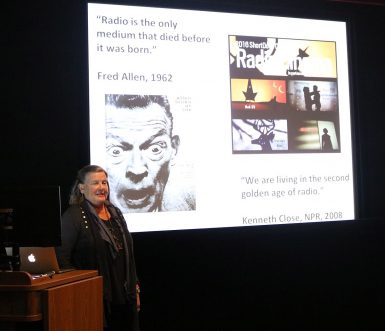Hilmes delivers Naremore Lecture on radio revival

In radio features, audio must replace all images for the listeners, both an art and a challenge years before digital storytelling emerged.
Michele Hilmes, professor emerita at the University of Wisconsin, shared her research in her talk, “Photography in Sound: The Radio Feature and Its Digital Revival,” March 8 as a guest of the Naremore Lecture series.
Hilmes said her work focuses on radio as storytelling from its beginnings and through technological changes.
“I find it astonishing that we have so little scholarship on this period — the whole period of radio, not in terms of its figures or its industry, but in terms of its creative expression,” she told her audience in the Wells Library.
Radio has a unique history, starting with early live productions. Hilmes said until the emergence of magnetic tape, radio shows were produced like stage shows. Actors had to be on the set to deliver their lines at the right time, audio assistants had to be ready with sound effects and even commercials were live.
Early on, field recording to capture environmental sound was complicated because equipment was huge and bulky, not easily transported.
“There were several techniques that were used to try to bring reality, the world outside the studio, into radio,” Hilmes said.
Hilmes noted kaleidosonic actuality and intimate actuality as two techniques used in radio features to help listeners visualize the stories. Kaleidoscopic actuality is the use of sometimes over-the-top sounds to create an emotional effect. The technique can be heard in Norman Corwin’s “On a Note of Triumph.”
Intimate actuality is heard in first person singular radio features. They are close to your ear and instill trust in a single speaker, Hilmes said.
Radio has survived and thrived from those years and remains an important storytelling medium. The introduction of podcasts and new delivery digital delivery systems has revived the popularity of audio stories.
While Hilmes focuses on historical use of sound, she urged her audience to participate, whether in examining radio’s past or future.
“I think we’re entering a new era of sound, and I hope you’ll all go out and listen more,” Hilmes said.
The Media School sponsors the Naremore Lecture series in honor of James Naremore, chancellor’s professor emeritus in communication and culture, English and comparative literature. Hilmes earned her bachelor’s degree in comparative literature at Indiana University at a time when people like Naremore were working to make a film studies program a reality.
After years as a faculty member, teaching and conducting research, Hilmes chose to study the history of sound in radio as her retirement project.
“She serves as a model for the oft repeated lesson that we are never really done learning anything,” said doctoral James Gilmore, who introduced Hilmes. “Dr. Hilmes has been perhaps inadvertently a part of how I learned to research media history and to ask historical questions.”
More:

